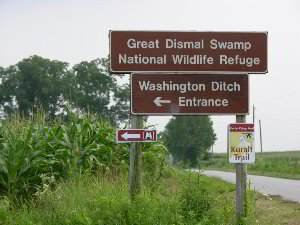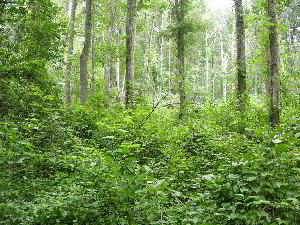|
==============================================================================
TOPIC: The Great Dismal Swamp NWR
http://groups.google.com/group/entstrees/browse_thread/thread/8be889cefee02c05?hl=en
==============================================================================
== 1 of 2 ==
Date: Mon, Jan 28 2008 7:17 pm
From: "Edward Frank"
The Great Dismal Swamp National Wildlife Refuge, VA, NC
ENTS,
I visited the Great Dismal Swamp National Wildlife Refuge in
Southeastern Virginia July 7, 2005. It was part of a longer trip and
I was in the vicinity and wanted to check it out.. It was hard to
find and not well marked and I drove around a number of back roads
before I found the entrance to the Wildlife Refuge itself It is an
interesting place and I hope to go back. It was the first place I
ever encountered tree sized holly, and it was really the first time
I noticed bald cypress. I had seen bald cypress before, but never
had really thought much about them. It was before I became involved
in trees and trees were not really very high on my radar. It was a
hot humid afternoon and the flies were biting as I walked around the
raised boardwalk at Dismal Town. What earlier in the season would
have been flooded ground was by this date relatively dry and
populated by a variety of vegetation. The bees were out. I got stung
by a bumblebee. I thought to myself that I need to come back here
sometime in the spring when the water is higher and it has more of a
swamp-like appearance. On that day it was just a mass of vegetation.
None of the trees were particularly large in the area I visited. It
had been logged and channelized in several attempts to drain the
swamp, or to push a canal through the area. I spent a couple hours
here before leaving, I wanted to spend more time, but I needed to
make Cape Hatteris that evening and I had spent to much time looking
for the place. The spring would be the time to visit. The
descriptions below from the NWR homepage report The dwarf trillium
is located in the northwestern section of the swamp and blooms
briefly each year for a two-week period in March.


Photo 1: Entrance,
sign;
Photo 2: Mass of vegetation on the forest floor


Photo 3: Bald
Cypress;
Photo 4: Holly tree
The material below is copied from the Great Dismal Swamp National
Wildlife Refuge website:
http://www.fws.gov/northeast/greatdismalswamp/
The Great Dismal Swamp National Wildlife Refuge is located in
southeastern Virginia and northeastern North Carolina. The refuge
consists of over 111,000 acres of forested wetlands. Lake Drummond,
at 3,100 acres and the largest natural lake in Virginia, is located
in the heart of the swamp.
The Great Dismal Swamp National Wildlife Refuge trails are open
everyday for hiking and biking from sunrise to sunset unless
otherwise posted. The refuge headquarters is located at 3100 Desert
Road in Suffolk, Virginia, and is open Monday through Friday, 7:30
am - 4:00 pm. The headquarters is closed on weekends and federal
holidays, the hiking and biking trails remain open.
The primary purpose of the refuge's resource management programs is
to restore and maintain the natural biological diversity that
existed prior to the human-caused alterations. Essential to the
swamp ecosystem are its water resources, native vegetative
communities, and varied wildlife species . Water is being conserved
and managed by placing water control structures in the ditches.
Plant community diversity is being restored and maintained through
forest management activities which stimulate the ecological effects
of wildfires. Wildlife is managed by insuring the presence of
required habitats, with hunting used to balance some wildlife
populations with available food supplies.
Five major forest types and three non-forested types of plant
communities comprise the swamp vegetation. The forested types
include pine, Atlantic white-cedar, maple-blackgum,
tupelo-baldcypress, and sweetgum-oak poplar. The non-forested types
include a remnant marsh, a sphagnum bog, and an evergreen shrub
community. Currently red maple is the most abundant and widely
distributed plant community, as it expands into other communities
due to the lingering effects of past forest cutting, extensive
draining, and the exclusion of forest fires. Tupelo-baldcypress and
Atlantic white-cedar, formerly predominant forest types in the
swamp, today account for less than 20 percent of the total cover.
Three species of plants deserving special mention are the dwarf
trillium, silky camellia, and log fern. The dwarf trillium is
located in the northwestern section of the swamp and blooms briefly
each year for a two-week period in March. Silky camellia is found on
the hardwood ridges and in the northwestern corner of the refuge.
The log fern, one of the rarest American ferns, is more common in
the Great Dismal Swamp than anywhere else.
A variety of unpaved roads provides opportunities for hiking and
biking. Recommended is the Washington Ditch Trail, a 4 1/2 mile
route to Lake Drummond and the elevated wooden Dismal Town Boardwalk
Trail, located adjacent to the Washington Ditch parking area. The
boardwalk meanders for a mile through a representative portion of
swamp habitats.
Human occupation of the Great Dismal Swamp began nearly 13,000 years
ago. By 1650, few native Americans remained in the area, and
European settlers showed little interest in the swamp. In 1665,
William Drummond, a governor of North Carolina, discovered the lake
which now bears his name. William Byrd II led a surveying party into
the swamp to draw a dividing line between Virginia and North
Carolina in 1728. George Washington first visited the swamp in 1763
and organized the Dismal Swamp Land Company that was involved in
draining and logging portions of the swamp. A five-mile ditch on the
west side of the refuge still bears his name. Logging of the swamp
proved to be a successful commercial activity, with regular logging
operations continuing as late as 1976. The entire swamp has been
logged at least once, and many areas have been burned by periodic
wildfires.
The Great Dismal Swamp has been drastically altered by humans over
the past two centuries. Agricultural, commercial, and residential
development destroyed much of the swamp, so that the remaining
portion within and around the refuge represents less than half of
the original size of the swamp. Before the refuge was established,
over 140 miles of roads were constructed to provide access to the
timber. These roads severely disrupted the swamp's natural
hydrology, as the ditches which were dug to provide soil for the
road beds drained water from the swamp. The roads also blocked the
flow of water across the swamp's surface, flooding some areas of the
swamp with stagnant water. The logging operations removed natural
stands of cypress and Atlantic white-cedar that were replaced by
other forest types, particularly red maple. A drier swamp and the
suppression of wildfires, which once cleared the land for seed
germination, created environmental conditions that were less
favorable to the survival of cypress and cedar stands. As a result,
plant and animal diversity decreased.
The swamp is also an integral part of the cultural history of the
region and remains a place of refuge for wildlife and people. The
dense forests of the Great Dismal Swamp provided refuge to runaway
slaves, resulting in the refuge becoming the first National Wildlife
Refuge to be officially designated as a link in the
"Underground Railroad Network to Freedom" in 2003.
Establishment of the refuge began in 1973 when the Union Camp
Corporation donated 49,100 acres of land to The Nature Conservancy.
This land was then conveyed to the Department of the Interior, and
the refuge was officially established through The Dismal Swamp Act
of 1974.
Trees
|
Loblolly
Pine
Pond
Pine
Bald
Cypress
Atlantic
white cedar
Red
Cedar
Black
Willow
Swamp
Cottonwood
Hop
Hornbeam
Musclewood
American
Beech
White
Oak
Overcup
Oak
Swamp
Chestnut Oak
Southern
Red Oak
Cherrybark
Oak
Water
Oak
Willow
Oak
Laurel
Oak
Post
Oak
Black
Oak
Yellow
Poplar
Southern
Magnolia
Sweetbay
Pawpaw
Redbay
Sassafras
Sweet
gum
American
sycamore
Washington
Thorn
Shadbush
American
Holly
Box
Elder
Red
Maple
Silky
Camellia
Black
Gum
Tupelo
Gum
Dogwood
Sourwood
Persimmon
Horse
Sugar
Green
Ash
Pumpkin
Ash
Black
Cherry
|
Pinus
taeda
Pinus
serotina
Taxodium
distichum
Chamaecyparis
thyoides
Juniperus
virginiana
Salix
nigra
Populus-heterophylla
Ostrya
virginiana
Carpinus
caroliniana
Fagus
grandifolia
Quercus
alba
Quercus
lyrata
Quercus
michauxii
Quercus
falcata
Quercus
pagoda
Quercus
nigra
Quercus
phellos
Quercus
laurifolia
Quercus
stellata
Quercus
velutina
Liriodendron
tulipifera
Magnolia
grandifolia
Magnolia
virginiana
Asimina
triloba
Persea
borbonia
Sassafras
albidum
Liquidambar
styraciflua
Platanus
occidentalis
Crataegus
phaenopyrum
Amelanchier
canadensis
Ilex
opaca
Acer
negundo
Acer
rubrum
Stewartia
malacodendron
Nyssa
sylvatica
Nyssa
aquatica
Cornus
florida
Oxydendrum
arboreum
Diospyros
virginiana
Symplocos
tinctoria
Fraxinus
pennsylvanica var. subintegerrima
Fraxinus
tomentosa
Prunus
serotina
|
Shrubs
|
Wax
Myrtle
Tag
Alder
Virginia
Willow
Swamp
Rose
Red
Chokeberry
Wild
Azalea
Swamp
Azalea
Sheep
Laurel
Male-Berry
Fetter-Bush
Dog-Hobble
Fetter
Bush
Poison
Sumac
Winged
Sumac
Winterberry
Inkberry
Sweet
Gallberry
Strawberry
Bush
Devil's
Walking Stick
Sweet
Pepperbush
Highbush
Blueberry
French
Mulberry
Possumhaw
Virburnum
Elderberry
Titi
Groundsel-Tree
Silky
Camellia
|
Myrica
cerifera
Alnus
serrulata
Itea
virginica
Rosa
palustris
Pyrus
arbutifolia
Rhododendron
nudiflorum
Rhododendron
viscosum
Kalmia
augustifolia
Lyonial
ligustrina
Lyonia
lucida
Leucothoe
axillaris
Leucothoe
racemosa
Rhus
vernix
Rhus
copallina
Ilex
verticillata
Ilex
glabra
Ilex
coriacea
Euonymus
americanus
Aralia
spinosa
Clethra
alnifolia
Vaccinium
corymbosum
Callicarpa
americans
Viburnum
nudum
Sambucus
canadensis
Cyrilla
racemiflora
Baccharis
halimifolia
Stewartia malacodendron
|
Edward Frank
== 2 of 2 ==
Date: Mon, Jan 28 2008 7:55 pm
From: Larry
Ed, Looks like a cool place! Isn't it amazing that they cut
everything in these places. I'm sure there are some old cypress in
there somewhere. Looks like a boat trip.
Larry
==============================================================================
TOPIC: The Great Dismal Swamp NWR
http://groups.google.com/group/entstrees/browse_thread/thread/8be889cefee02c05?hl=en
==============================================================================
== 1 of 1 ==
Date: Mon, Jan 28 2008 9:24 pm
From: James Parton
Ed,
It looks like a nice place to visit. A swamp would be a change for a
mountain dweller like me.
JP
|